45 Most Unbelievable Natural Phenomena You Didn’t Know Existed
Nature is the purest art. This article explains the world’s most surreal natural phenomena, from scenic views to strange patterns and unexplainable scenes. You will discover why some beaches glow, the mystery of fairy circles, and other cool natural things that you have no idea exist.
The world is truly a beautiful place filled with wonder. Let’s venture around the world together and explore some of the most unbelievable natural phenomena!
1. The Doorway to Hell In Turkmenistan
In 1971, Soviet geologists speculated that a natural gas reserve existed in the Karakum desert in Turkmenistan. They drilled an exploratory well to confirm. They were right! They discovered methane gas, the main component of natural gas. Also, a highly flammable greenhouse gas.
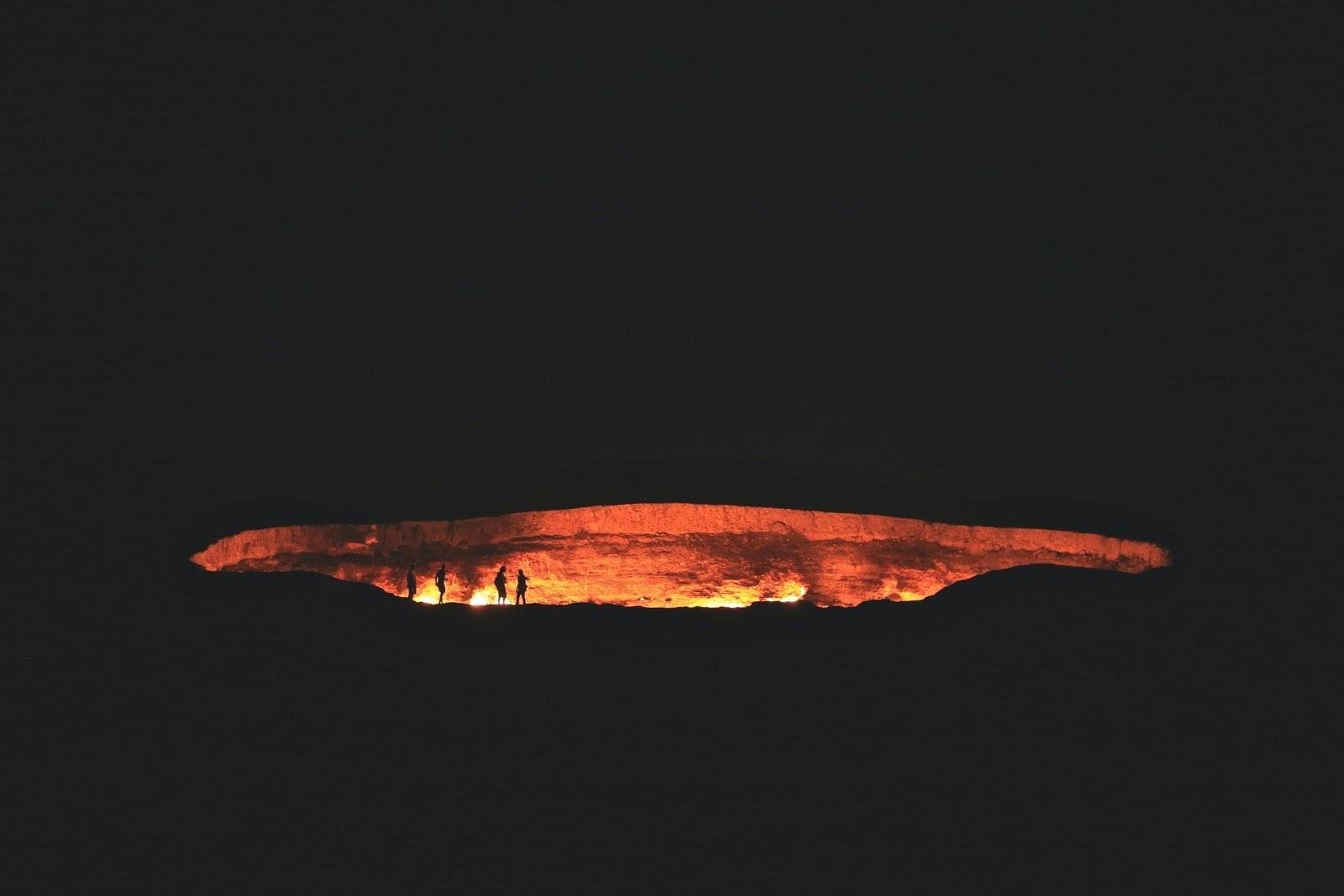
Image Source: disruptivecapital.com
But soon after the confirmation, the exploratory well collapsed into a wide crater. Thinking the methane would burn up in weeks, the geologists set it on fire. But it is among the world’s largest natural gas reserves. The doorway to hell is still burning today.
2. Volcano Producing Lightning
Speaking of hell—there have been over 200 documented occurrences of lightning in volcanic eruptions. They happen in the same way as lightning during storms. Volcanic ash particles collide with each other like ice in clouds. Each particle gets a static charge, either positive or negative.
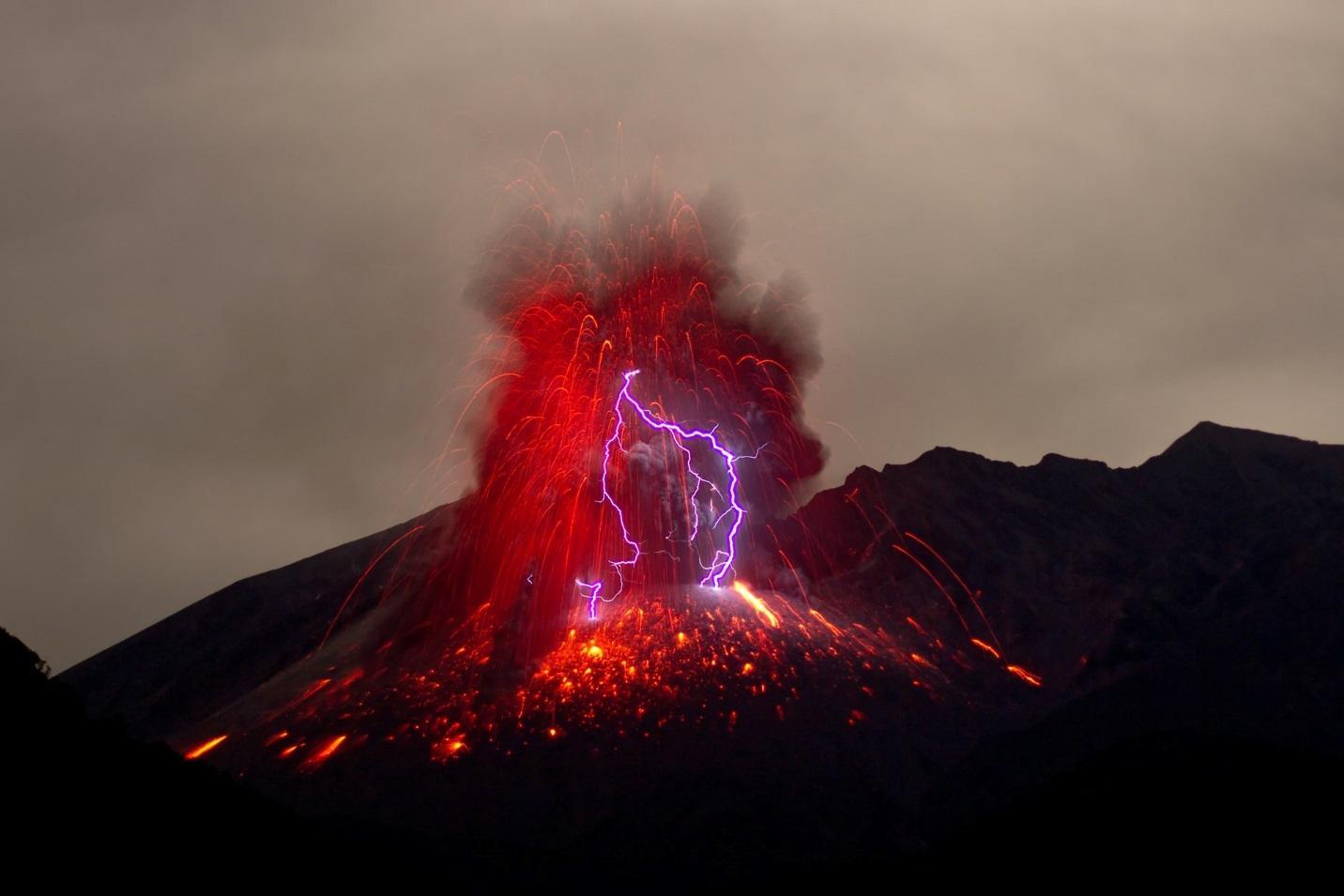
Image Source: cristaos.org
When oppositely charged particles collide within the volcanic plume, they create an electric field marked by a lightning strike. Volcanic lightning is a dark yet magnificent show! It is famous by the name, dirty thunderstorm.
3. The Everlasting Storm In Venezuela
The Catatumbo lightning in Venezuela holds a Guinness World Record title for the highest lightning concentration. Researchers estimate that the area where River Catatumbo enters Lake Maracaibo receives lightning flashes up to 300 nights a year, each lasting 9 hours on average.
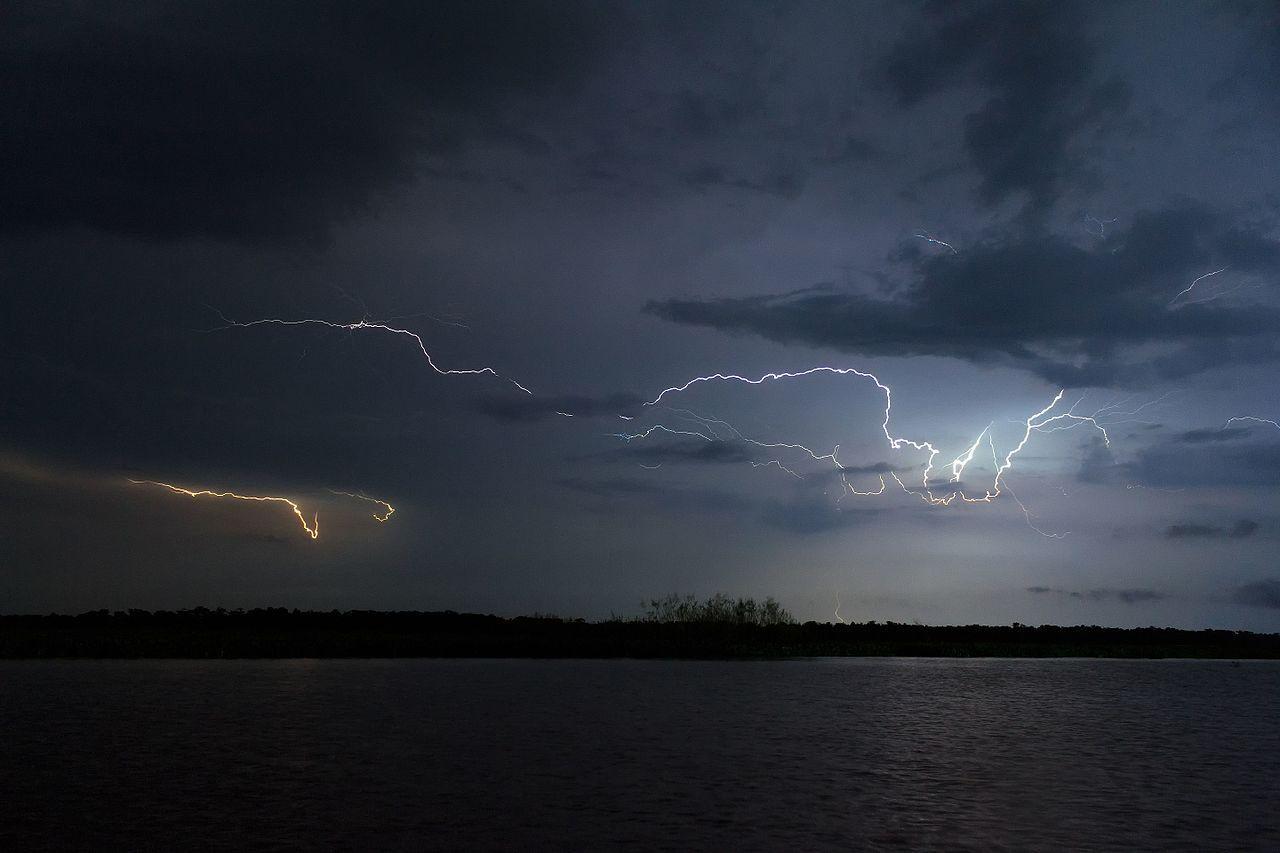
Image Source: Wikimedia Commons
This spectacular show is a significant tourist attraction. Scientists are yet to pinpoint the exact cause of the never-ending lightning. One study concluded that when warm air meets cold air, they create an electric charge resulting in lightning.
4. Volcanos That Burn Blue
While most volcanos burn red, some burn blue, like the Dallol Mountain in Ethiopia. The blue fire is a result of high levels of Sulphur. When you burn Sulphur in oxygen, it glows blue. It is hotter than a red flame.

Image Source: Travlerz
When the Sulphur melts, it rolls down the volcano carrying with it blue flames. It then appears like blue lava. These blue flames are best observed in night hours. Similar blue flames are observed when wildfires erupt in the Yellowstone National Park, which has high Sulphur levels.
5. The Strange Underwater River
Sinkholes are famous diving spots. But under the crystal-clear freshwaters of Cenote Angelita in Mexico, there’s a salty underground river complete with ghostly trees. Where the freshwater meets the denser saline water, there’s a surreal misty layer called a halocline.
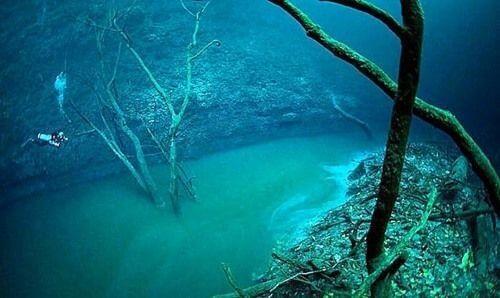
Image Source: Travlerz
The deep-sea photographer, Anatoly Beloschin, captured this phenomenon first. Beneath the halocline, you will need even brighter lights to navigate the abyss. If you love dark and thrilling adventures, this is an adventure worth scuba diving lessons.
6. The Great Blue Hole
The Great Blue Hole is among the best scuba diving spots worldwide. It is also a major tourist destination. The massive sinkhole off the Belize coast features a lighter blue shade near the surface and darker blue as you sink deeper into the sinkhole’s waters.
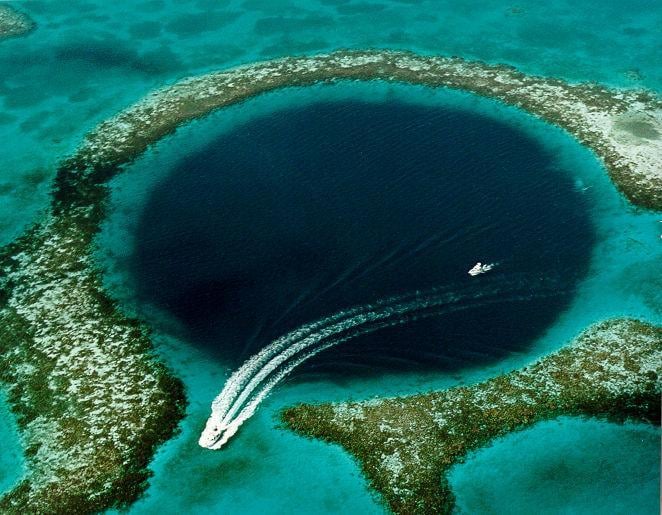
Image Source: Wikimedia Commons
The great blue hole started as a limestone cave during the ice age. As the sea level rose, water flooded in the cave. The water collapsed the cave to form a deeper vertical cave in the ocean called the Great Blue Hole.
7. Crop Circles Found Underwater
Yoji Ookata was the first man to photograph an underwater crop circle near Japan’s coast. It was a compelling pattern with intricate features carved on the sea bed. It resembled the mysterious crop circle formations on cornfields in the ’70s.
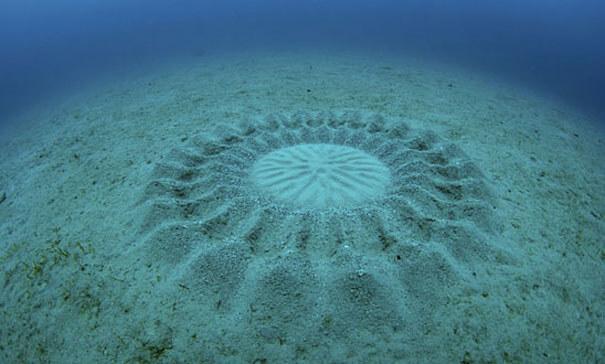
Image Source: Travlerz
Ookota brought in Japan’s NHK TV crew to document it. They soon found the artist: a white-spotted pufferfish who would work day and night for a week. The art was a breeding area with many nests. Yet, the female would only choose one nest to lay her eggs.
8. Glowing Beaches In Maldives
Bioluminescent (glowing) waves flowing on the beach are common in Vaadhoo Island in the Maldives, Mosquito Bay, Laguna Beach, and Puerto Rico shores. All the color shades (blues, greens, and reds) come from bioluminescent microorganisms and other sea creatures. Bioluminescent microorganisms are like fireflies: they emit light through chemical reactions.
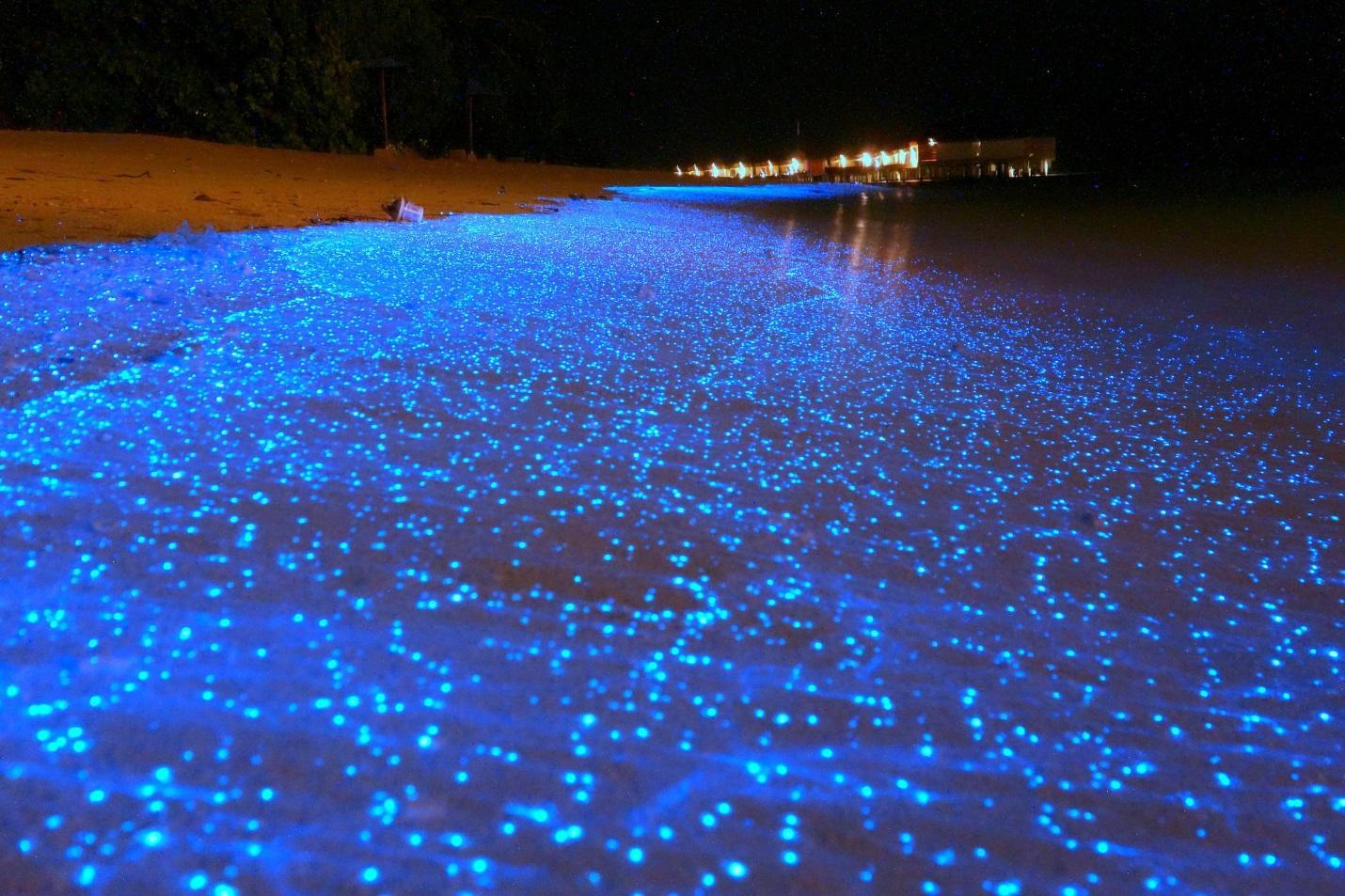
Image Source: fb.ru
During the night, bioluminescent zooplankton (like copepods) come to the water surface to feed on bioluminescent algae (phytoplankton). These bioluminescent organisms create surreal blue, green, and red waves perfect for a romantic setting.
9. Auroras Across The Sky
An aurora is a colorful display of green, blue, yellow, red, and orange lights that move gently in the sky. These sightings are famous in the north pole and south pole regions.
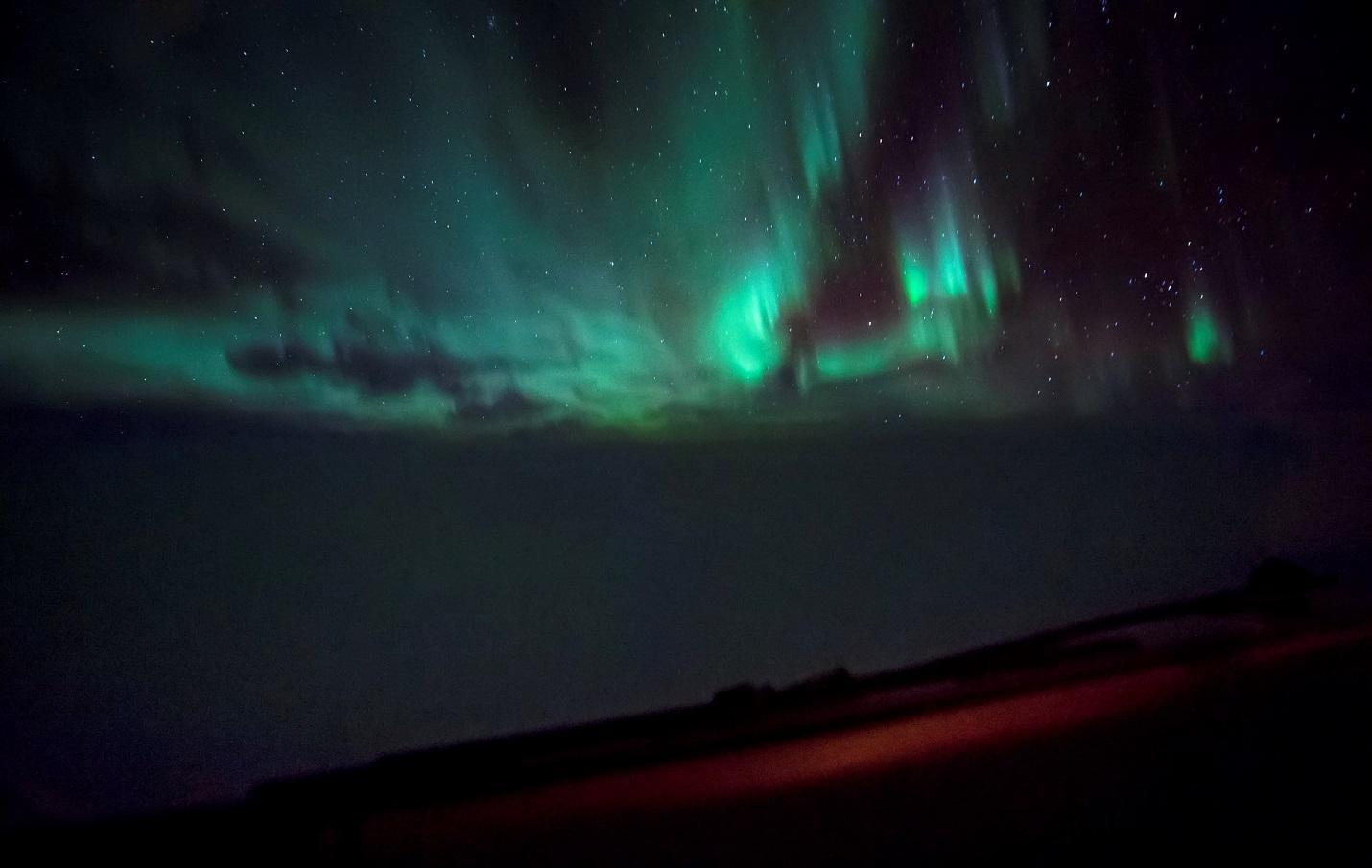
Image Source: fb.ru
An aurora happens when the sun’s ions (called solar wind) collide with atoms in the earth’s atmosphere. The collision releases energy that results in a glowing halo in the sky. If the ions collide with oxygen atoms, the result is red, green, and yellow lights. When they collide with nitrogen atoms, they result in bluish light.
10. Light Pillars At Night
Light pillars are a common sight in cold regions like in Russia. They are vertical rays painting the horizon in distinct colors. These colors usually resemble the source of light, like the moon.Unlike other natural color displays, a light pillar’s source can also be artificial, like a streetlight.
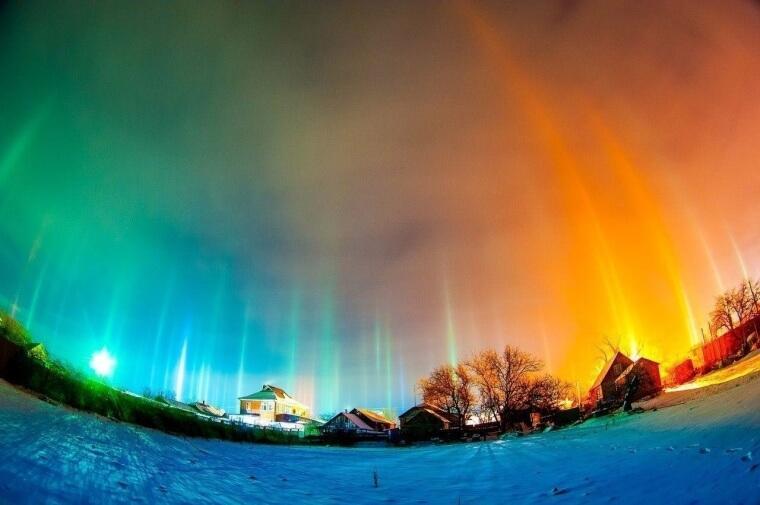
Image Source: Travlerz
Light pillars form when light interacts with ice crystals suspended in the air. The ice crystals reflect the light, trajecting a colored light beam. The light beam is even more stunning when the air is saturated with ice crystals.
11. White Rainbows (Fog Bows)
Regular multicolored rainbows form after raindrops refract (bend) the sunlight rays. But fog bows happen when much smaller fog droplets refract the sun rays. Fog droplets result in a white or almost colorless bow.
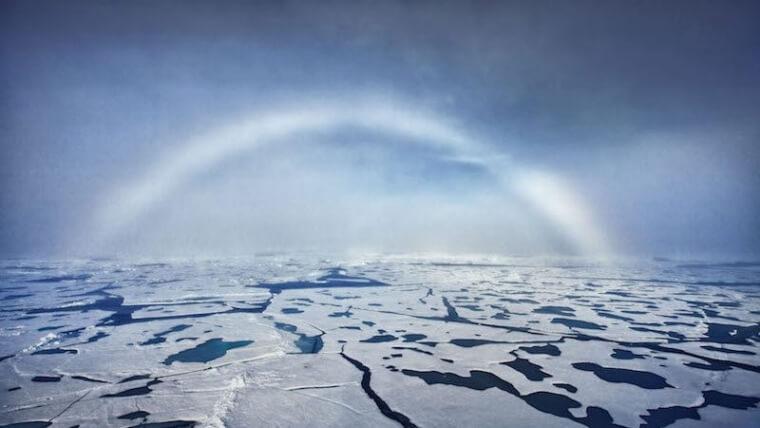
Image Source: Travlerz
The result is a weakly colored white bow. When all the fog droplets have the same size, the resulting fog bow may have different layers of intensely colored white rings. Fogbows always appear in the opposite direction of the sun. When they happen at night, they are called lunar bows.
12. The Rainbow Mountains of China
In China, there are rainbow-colored mountains with winding paths and scenic views. Tourists flock to the Zhangye Danxia Geopark for a ride through the Danxia rainbow-colored landforms.
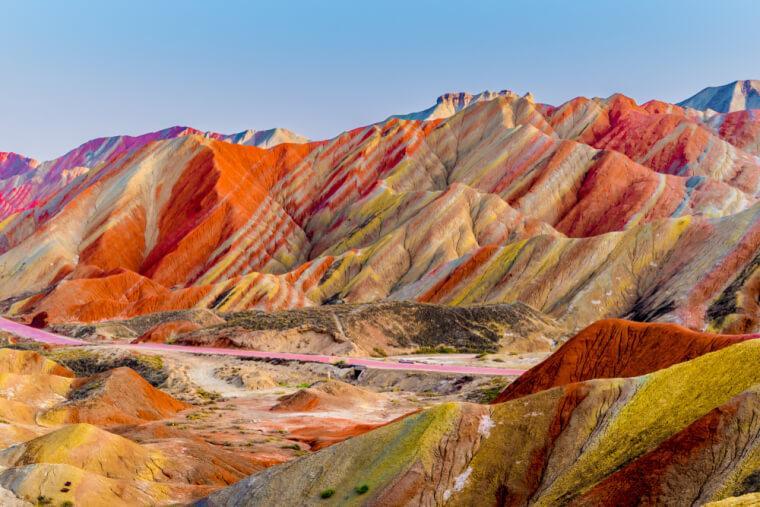
Image Source: Travlerz
Red is the primary color of the landforms. That’s because most rocks in the region are red sandstones. Groundwater that passes through the cracks in these rocks leaves behind mineral deposits. These minerals react with oxygen, forming differently colored oxides. The result is the rainbow colors you see on the Danxia landforms. The rainbow-colored mountains were listed in The World Heritage List in 2010.
13. Striped Icebergs In Antarctica
Like the Danxia colored landforms, the striped icebergs in Antarctica get the different colors from the ice’s physical composition. Usually, icebergs are white because there are bubbles trapped within. When water freezes within the ice cracks so fast that no bubbles are trapped, it forms blue stripes.
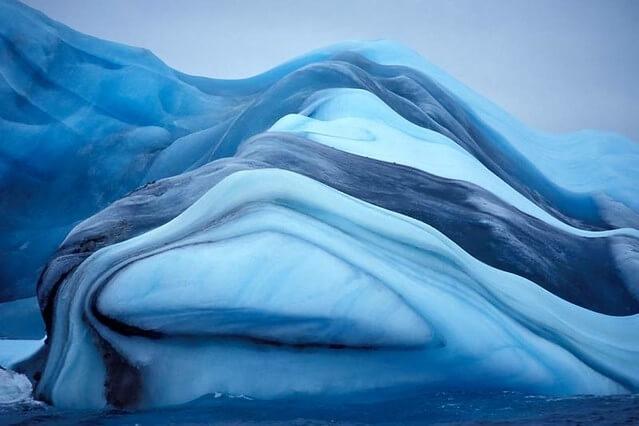
Image Source: Travlerz
Icebergs get other different colors from minerals and dead algae. The algae matter creates different shades of yellow, brown, and green. When the frozen water contains sediments picked up by rolling water, it forms black stripes.
14. The Reflecting Salt Desert In Bolivia
Salar De Uyuni is the world’s largest saline plateau. Stretching up to 10,000 square kilometers, this uniquely flat salt flat is the remains of the saline Lake Coipasa. The lake dried out about 1340 years ago.
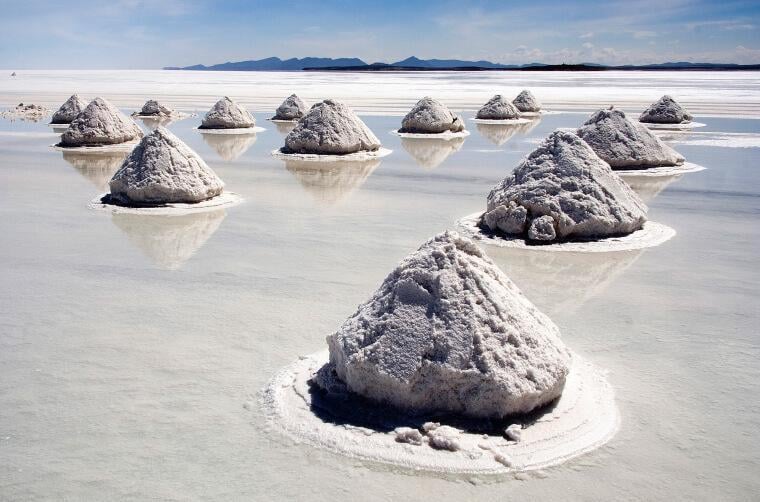
Image Source: Travlerz
Salar De Uyuni’s extensive surface is saturated with salt and chlorides. After rains, the surface forms a gigantic reflective mirror that’s a sight to behold. The salt pan is a prime breeding ground for flamingos. It is also used as a filming location, like filming Star Wars: The Last Jedi and other movies.
15. The Eye Of The Sahara
Also called the Richat Structure, the Eye is a prominent dome in western Sahara. It resembles a bull’s eye when observed from space. It was first recorded by Gemini astronauts who used the eye as a landmark.
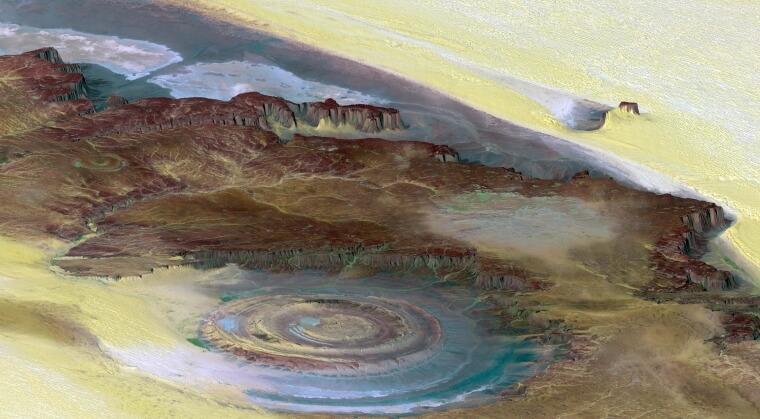
Image Source: Travlerz
The Eye features concentric rings of different rocks from different ages, some dating back 100 million years ago. Volcanic activity exposed the rock layers to erosion agents. Geologists hold that the eye is a result of deep wind and water erosion spanning over centuries.
16. The Forest Of Knives
The stone forest in Madagascar is a World Heritage Site featuring scenic razor-sharp limestone rocks, vegetation, and wildlife. Like the eye, geologists believe that the rocks formed after years of erosion from rainwater and groundwater. Tectonic plates movement exposed the limestone bedrock to these agents.
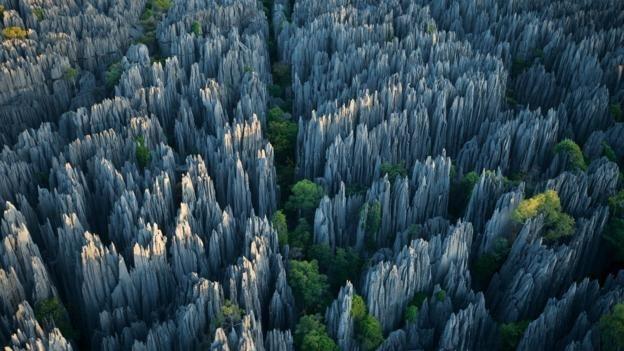
Image Source: Travlerz
Groundwater created caverns within the limestone bed till the cavern roofs collapsed to form rocky towers. Rainwater eroded the softer rock surfaces until all that was left were tough rocks. The stone forest is tough to navigate, but it’s a worthwhile adventure.
17. The Fairy Circles In Namibia
Fairy circles are moist bare circular patches about 2 meters wide surrounded by grass in the Namib desert. Two water-competition theories have been suggested to explain the mystical circles. One theory suggests that sand termites create the bare circles by clearing vegetation to make a porous water reservoir.
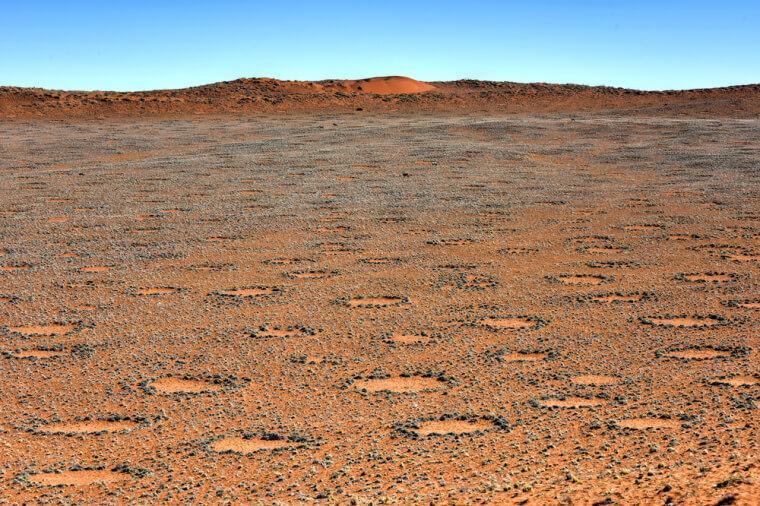
Image Source: Travlerz
Another theory suggests that the surrounding grass colonizes the circular region, preventing other plants’ roots from accessing the water reservoir. One research concluded that sand termites and grass activity are plausible explanations for fairy circles in the Namib desert.
18. Moeraki Boulders In New Zealand
The Moeraki boulders on New Zealand’s Otago coast are large spherical boulders that seem to be human-made. However, they are natural. These perfectly spherical boulders marked with large cracks could be as large as 9 feet wide.
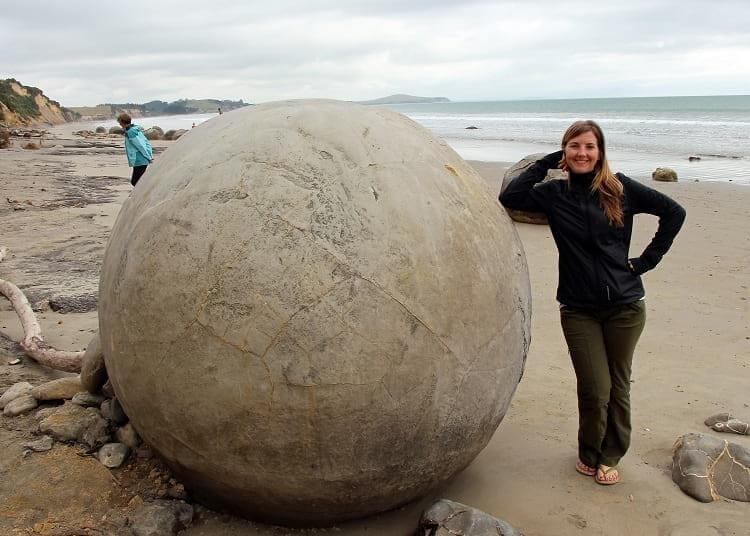
Image Source: Travlerz
The Moeraki boulders began as marine mud over 60 million years ago. The mudstone grew larger as more marine mud was collected and cemented around the boulder to form concretions. For many years, these boulders were buried in layers of mudstone. But as the waves washed away the mudstone layers, they revealed spherical boulders.
19. The Mesmerizing Starlings Murmurations
On first look, it’s a shape-shifting black disintegrated cloud moving fast across the sky. But on closer look, it’s a shoal of starlings moving across the sky as if with an internal compass. They migrate for food and breeding.
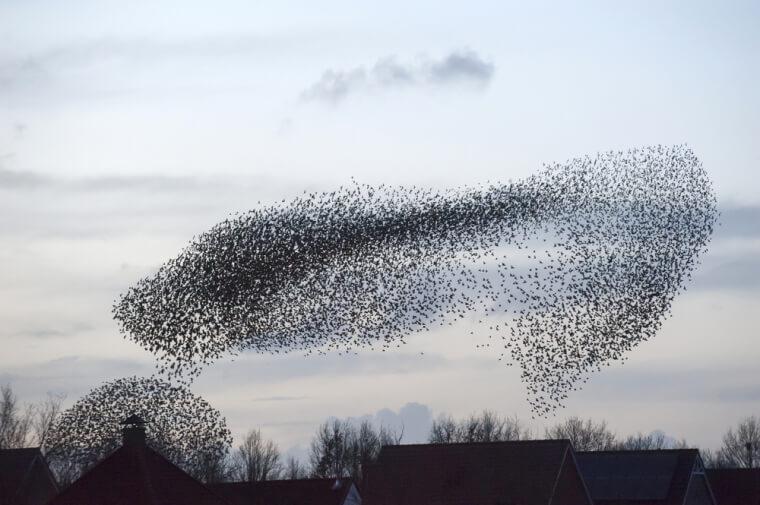
Image Source: Travlerz
A group of researchers set out to demystify this rhythmic migration pattern in 2010. They found that the starlings have no designated leader. Instead, when one starling changes direction, the rest follow suit immediately. Another study determined that each starling responds to the nearest seven starlings’ immediate movement.
20. The Million Sardine Run
The Sardine run is an epic phenomenon of millions of sardines followed closely by predators. Millions of sardines migrate from the Agulhas Bank to the Kwa-Zulu Natal coastline in South Africa. They migrate to breed around May and July.
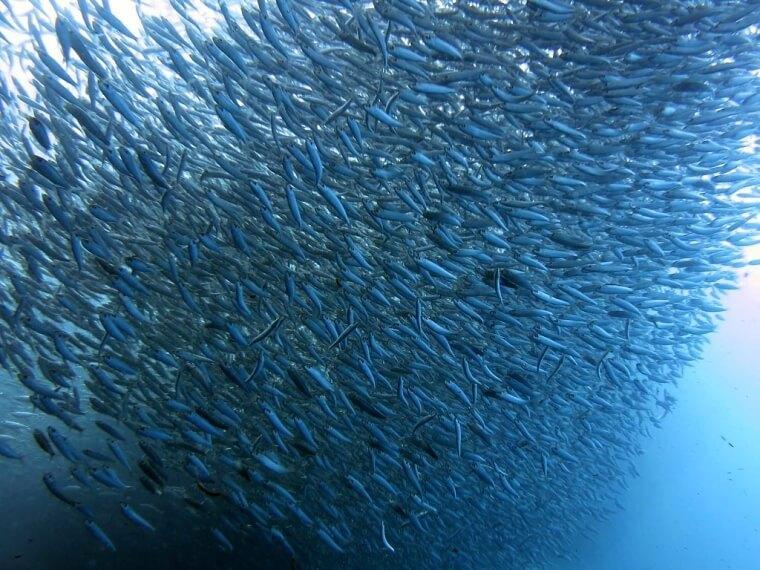
Image Source: Travlerz
Researchers suggest that the sardines migrate when seawater temperatures drop below 21 degrees Celsius. Each sardine has a lateral line that responds to pressure changes, allowing them to move in one large motion. When one sardine changes direction, the rest follow. It is similar to the starlings’ murmuration.
21. Red Crab Migration On Christmas Island
Red crabs are native to Christmas Island in Australia. Every year when the wet season begins (Oct to Nov), millions of red crabs migrate from their burrows in the forest to the seashores to mate.
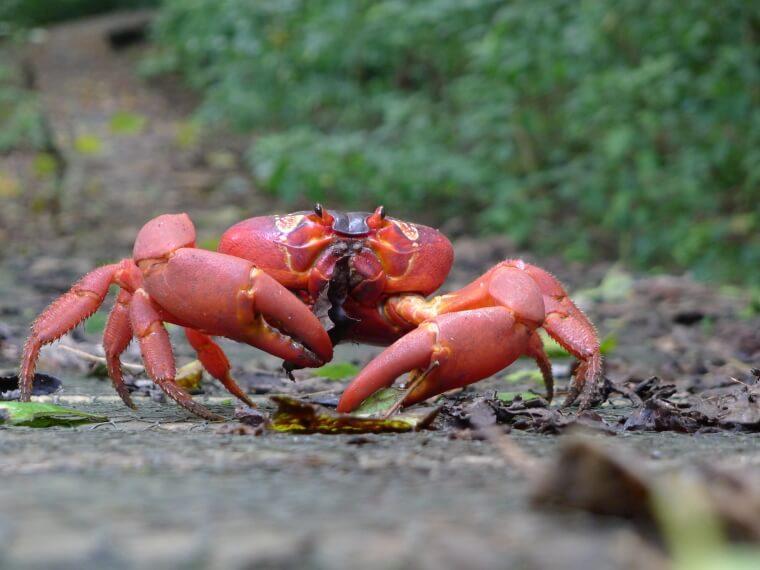
Image Source: Travlerz
These crabs follow the same paths year after year when going to and returning from their breeding journey. The migration can take up to 18 days as the crabs crawl over everything in their way in one mass movement. The red crabs time the migration such that the females will lay eggs and hatch them right before the high tides to release their hatched eggs in the sea.
22. Sudden Spider Rains In Australia
Spider rains happen during rainy seasons when spiders fly from the ground to the tallest structures near their habitat. They do this to avoid drowning. The spiders climb to the highest point and release the silky thread from their butt. They use this to fly to different places. The result is a massive covering of spider webs commonly called angel hair.
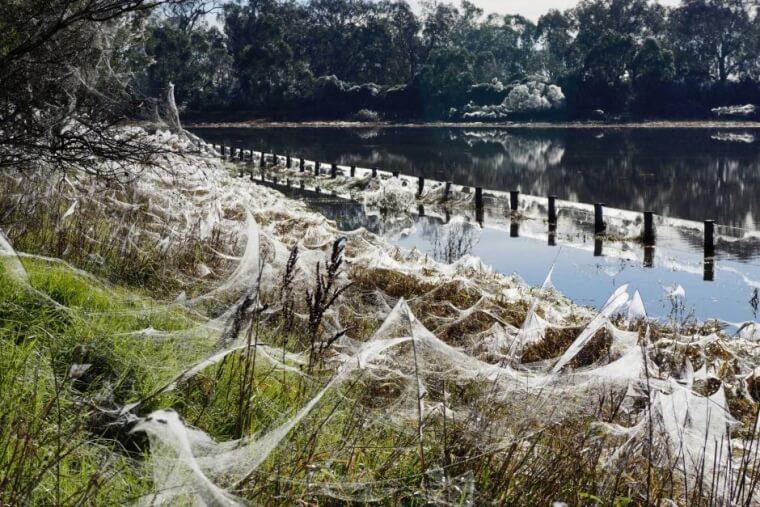
Image Source: Travlerz
Ballooning is another spider behavior that results in spider rain. As baby spiders migrate to find food, they travel using their threads and the wind. The thread forms a parachute.
23. Sailing Stones In Death Valley
The Racetrack Playa in Death Valley is scattered with stones that leave behind trail marks. The phenomena remained a mystery until two researchers planted cameras and GPS trackers on some rocks. They discovered that melting ice nudged the rocks into motion.
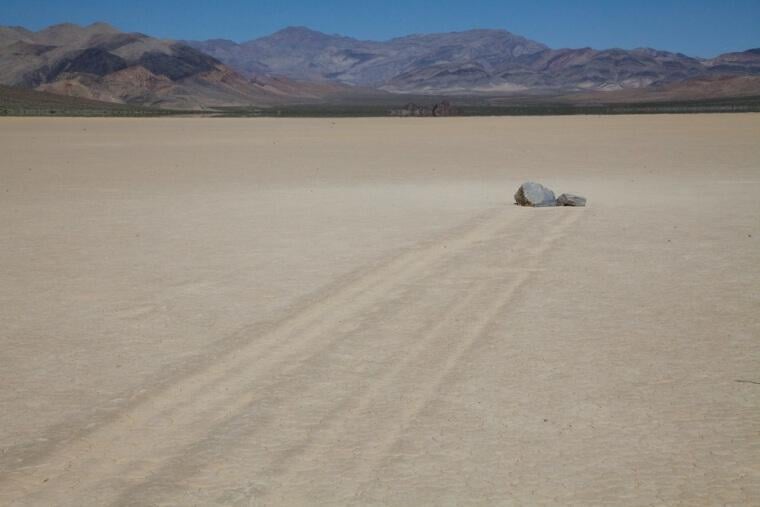
Image Source: Travlerz
First, rains fill up the playa with water. The water then freezes during winter nights. But in the daytime, the sun heats and melts the ice sheets, breaking them into floating ice panels. Wind pushes the ice panels, which in turn pushes the rocks to glide through the playa.
24. The Morning Glory Clouds
Morning glory clouds are a rare type of clouds observed in Burketown, Australia, in September and October. Morning glory clouds happen when two breezes from different directions meet in the day.
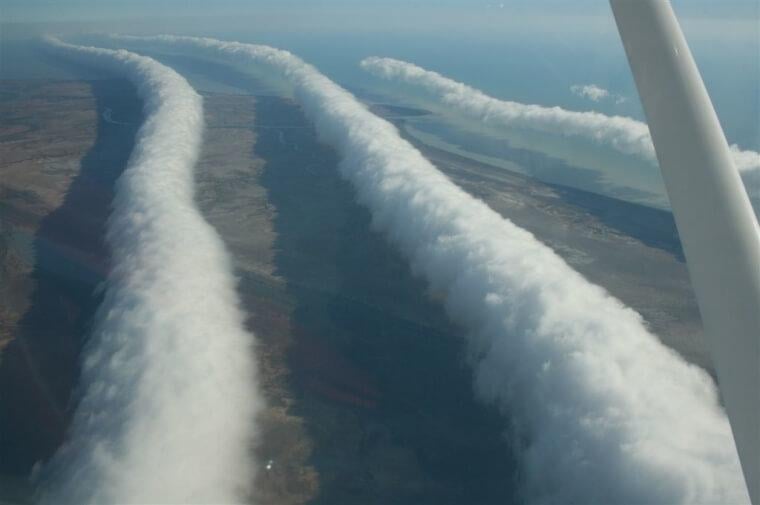
Image Source: Travlerz
At the collision point, air rises to form a line of clouds. When it gets colder at night, an inversion (an area where temperature rises with height) forms as the air condenses and starts to descend. The pattern continues with air rising in front and descending at the back of the cylinder. At high saturation, morning glory clouds form.
25. Stationary Lenticular Clouds (Resemble Flying Saucers)
Easily mistaken for a UFO sighting, lens-shaped clouds form on the downwind hill or mountainside. Though they may appear alone in the sky or among other clouds, lenticular clouds indicate instability in the earth’s lowest layer called the troposphere.
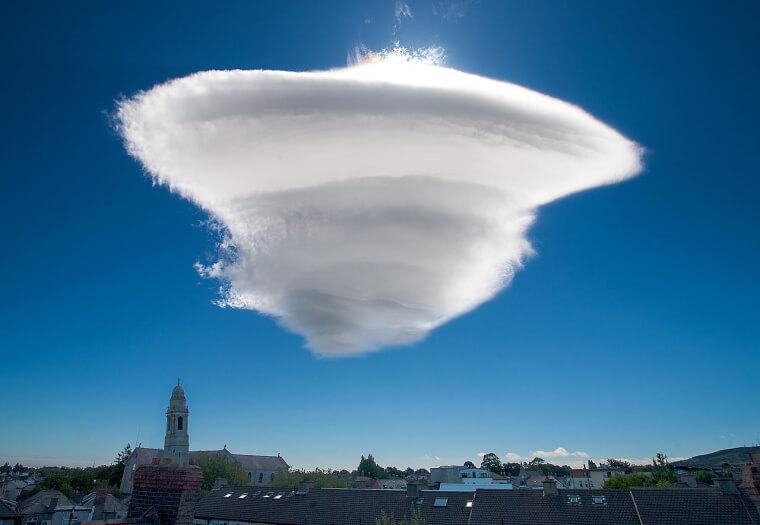
Image Source: Travlerz
Lenticular clouds are formed when valleys or mountains disrupt the airflow creating a turbulence area (eddy). When moist wind flows over the eddy and encounters low temperature, the water condenses to form a stationary lenticular cloud. They may disappear as suddenly as they appeared.
26. Frost Flowers In Antarctica
Frost flowers form during the cold season. They are not actual flowers. They are short-lived ice formations that look like petals protruding from the split stem of a plant. Frost flowers form in extremely low air temperature and moist soil.

Image Source: Travlerz
The plant’s roots absorb the soil water from the ground. As the water goes up the stem, it freezes and expands until the stem splits open. The water freezes instantly on exposure to cold air. As more water reaches the split stem, it forms protruding ice crystals that resemble petals, ribbons, or cotton candy.
27. The Rainbow Eucalyptus In Philippines
Most eucalyptus trees are native to Australia, except the rainbow eucalyptus (Eucalyptus deglupta) and three other eucalypt species. This eucalyptus with rainbow-colored barks belongs to the Philippines, Indonesia, and Papua Guinea.
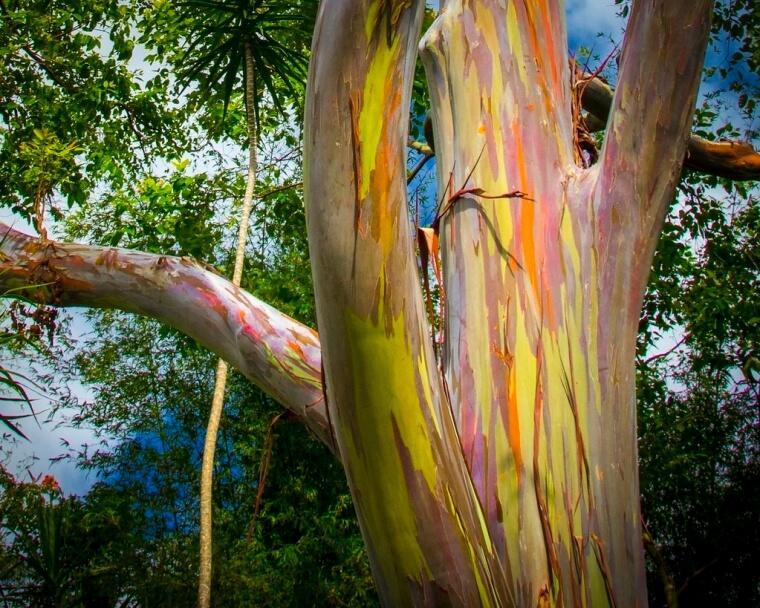
Image Source: Travlerz
While other eucalyptus trees grow in sub-tropical regions, this eucalypt species grows in lowland rainforests. The rainbow eucalyptus sheds its orange-tinted barks to reveal red, orange, brownish, and grayish streaks. It is no wonder that these trees are planted for their aesthetic value in Hawaii and other states.
28. The Dragon Blood Tree In Yemen
The dragon tree (Dracaena cinnabari) native to Yemen is famous for producing red sap when cut. The odorless sap has been used for many purposes, including medicinal and cosmetic uses.
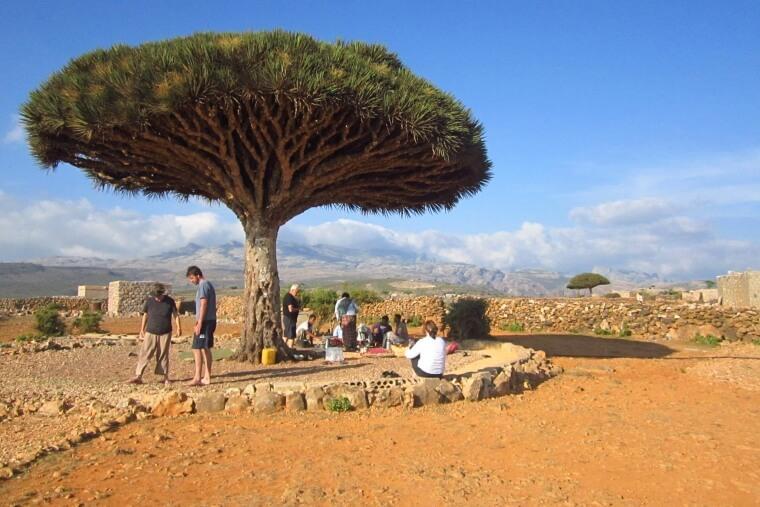
Image Source: Travlerz
Dating back 50 million years, the unique tree resembles a tall umbrella with ever-green leaves. The leaves grow at the branch edges and point upwards. The dragon tree thrives on rocky grounds and arid conditions. The densely packed leaves prevent excessive water loss just as they provide shade for people and animals. Additionally, the trees grow close together to survive on less water and soil.
29. Living Stones In Southern Africa
Living stones (lithops) are plants that look like stones. Their stony look and small stature protect them from predators. Lithops are succulent plants native to the southern African regions. The leaves are usually translucent allowing sunlight to pass through them for photosynthesis.
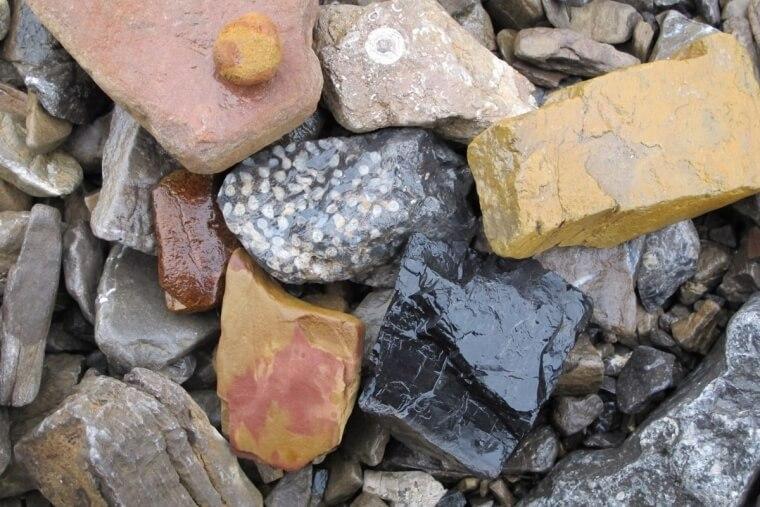
Image Source: Travlerz
The two joint leaves store enough water to last the lithops through a dry season. Everything about the plants, from the leaf’s patterns to the almost absent stems, creates the perfect camouflage and arid-area adaptation for the lithops. They need little maintenance, which makes them a popular houseplant.
30. Powerful Maelstroms In The Ocean
A whirlpool (similar to that observed in a kitchen sink) is water that spins and turns, drawing things inwards in the center of the vortex. When two strong currents (like tides) traveling in different directions meet, they form a mighty whirlpool called a maelstrom.

Image Source: Travlerz
The Maelstrom of Saltstraumen in Norway is the strongest in the world. Though smaller watercraft are usually the ones at risk of getting pulled into a maelstrom, large watercraft have to wait this one out. At its strongest, it runs 10metre wide and 5 meters deep.
31. Spotted Lake In Osoyoos
In Osoyoos, there’s a lake that forms natural walkways on the surface during summers. They look like large polka dots in the lake. The walkways form when water evaporates from the mineral-rich lake leaving behind a hardened circular crystal.

Image Source: Travlerz
The minerals arrive in the lake as run-off from surrounding areas. As water flows to the lake, it collects minerals like magnesium sulfate, titanium, and silver. When the crystals form, they resemble the present mineral’s color. The surreal spotted lake is closed off from the public to protect the reserve.
32. Frozen Methane Bubbles In Lake Abraham
Frozen methane bubbles are a usual sight in water bodies during the winter season. The process begins with dead organisms in the waterbody. When bacteria feed on these dead bodies, they release methane gas into the water.
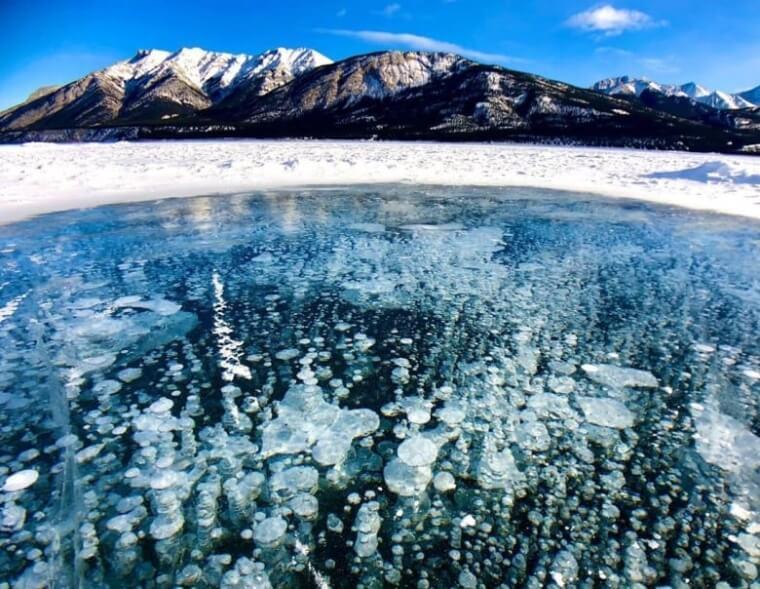
Image Source: Travlerz
On warm days, the gas quickly dissipates in the air. But during the winters, the water surface freezes, trapping the methane gas within the waterbody. Methane bubbles form on the water surface as floating white disks. When spring comes, the frozen bubbles melt, releasing the methane gas into the air.
33. The Ice-Cold Glacier Caves
Glacier caves are cold yet mesmerizing. Glacier caves form when ice in the glacier begins to melt, creating a cave between the ice and bedrock. Sometimes the caves form when underground heat melts a part of the ice within the glacier.
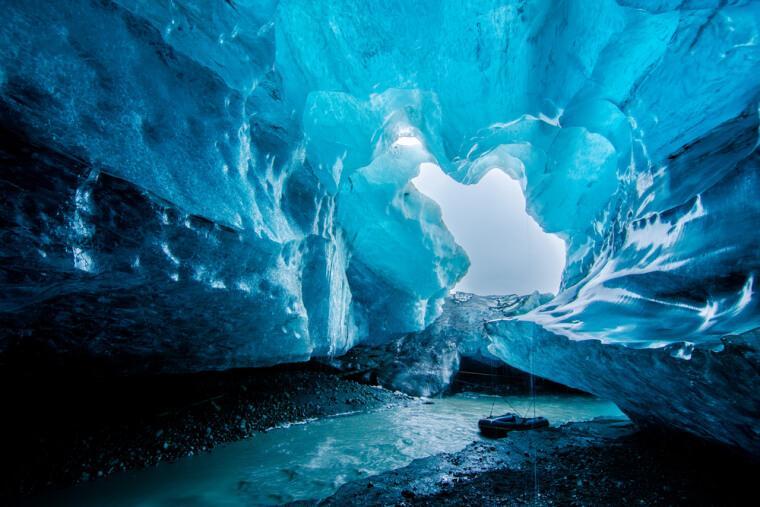
Image Source: Travlerz
Caves also form when meltwater from the glacier runs through the glacier’s bottom. Glaciologists use these caves to access the glacier’s interior. Ice water drops from their roofs, and sometimes rocks fall onto the cave’s floor when the ice melts.
34. The Cave Of The Crystals
The cave of the crystals is a limestone cave beneath the Naica mine in Chihuahua, Mexico. The cave is a chamber of giant gypsum crystals formed due to the extremely high temperatures and rich mineral content in the cavern.

Image Source: Travlerz
Below Naica, there’s a magma chamber that heats the mineral-saturated groundwater in the cavern. Over the past 500,000 years. The extreme heat crystallized the minerals in the water to form giant selenite crystals jotting from the walls and floor. The tallest crystals measure 36 ft high and 55 tones heavy.
35. The Scenic Amazonian Tidal Bores
How many times do you see a wave riding against the river’s current? A tidal bore happens when a tide pushes water against the river’s current.

Image Source: Travlerz
The Amazon river normally flows to the Atlantic Ocean. But when the ocean tide is highest, water flows from the Atlantic to the Amazon river, creating the noisy Amazonian tidal bores. The waves ride up to 13ft tall, traveling up to 500 miles into the Amazon river. The Amazonian Tidal Bores (or Poporoca) happen at least twice every year, around February and March. Surfers are always looking forward to these!
36. Icelandic Steam
How often did you play in the mud as a child? You expected to get dirty, of course, but did you ever consider that the mud might actually be boiling hot? Probably not. In fact, mud is often a cool place to be, which is what makes some of Iceland’s mud that much more interesting.
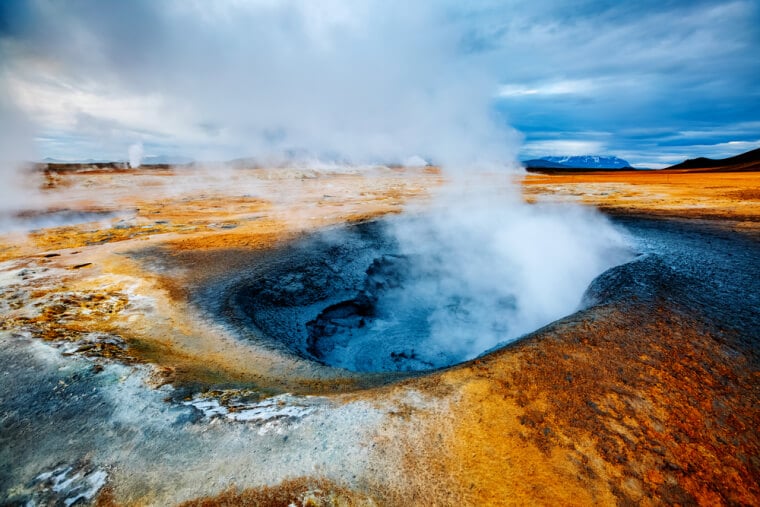
Source: flitto.com
In Hverir, there is mud so hot that it actually does boil and let off steam. When viewing the landscape, you see large clouds rising from the ground in various places. It’s probably not somewhere you’d like to let your kids run and play, but it makes for some breathtaking pictures.
37. Deadly Lake of Tanzania
Imagine stepping into a lake with the idea of getting a refreshing dip. Instead, you turn into a mummy. Is this the plot of a new horror film or the story of a nightmare? No. It’s the true story of the Deadly Lake in Tanzania.
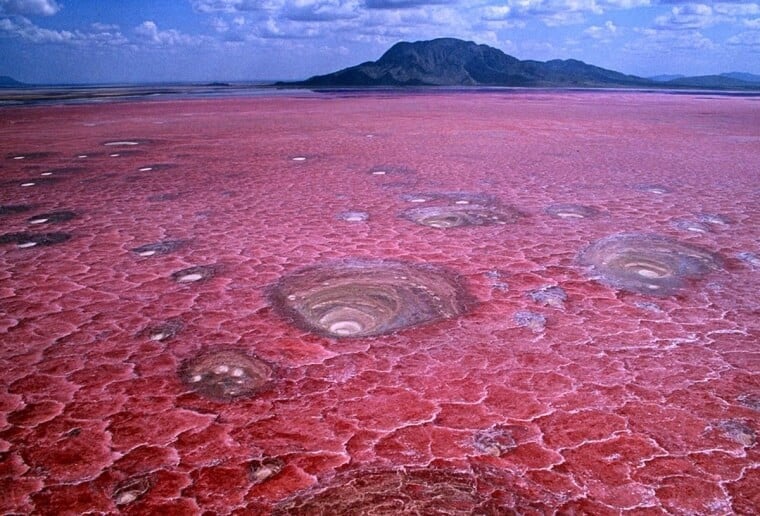
Source: imgur.com
While humans might be a little large for this to happen the mummification does actually occur to birds and other small animals. The lake is full of calcium carbonate. When a small creature ventures into the lake, it quickly calcifies. The lake is not exactly a great tourist destination, but it is an interesting and beautiful thing to see.
38. Snowy Volcano
When you think of a volcano, you typically think of hot, molten lava flowing over the sides, destroying everything in its wake. While this is normal, you might be surprised to learn that volcanoes do more than spew lava.
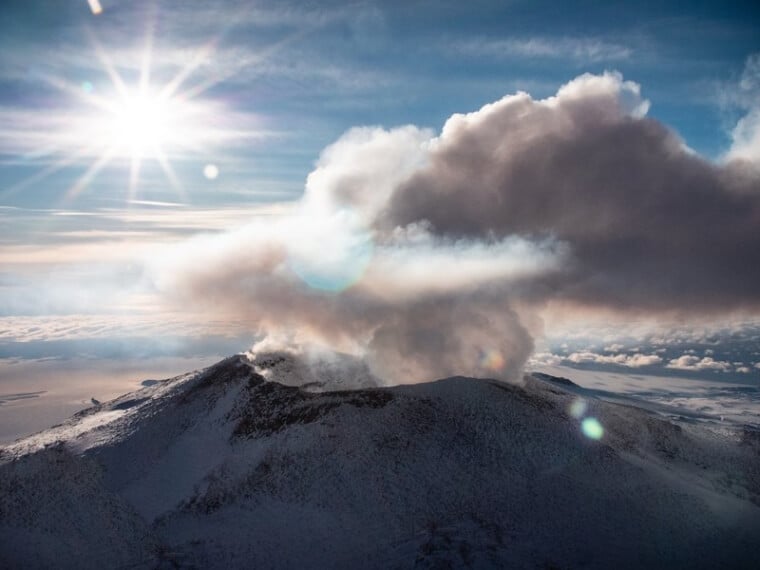
Source: PBS
In colder regions where volcanoes are present, the cool air fights against the heat. As this happens, huge steam clouds come out of the volcanoes, making them appear to be snowing. That’s a stark contrast to the normal view.
39. Agitated Clouds
Imagine walking out of your home one day, looking to the sky, and seeing clouds that could come straight from a horror novel. The clouds in this photo are apparatus clouds or agitated clouds. They look similar to the fake cobwebs you can purchase to decorate for Halloween.
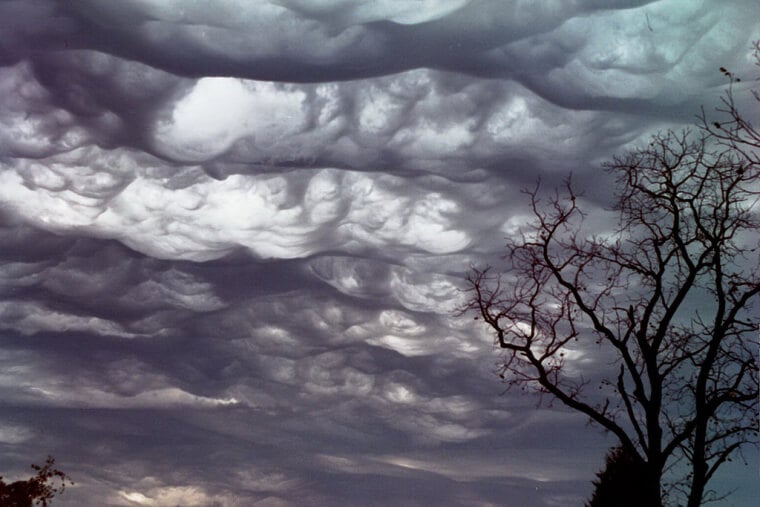
Source: pasabon.nl
Agitated clouds are both mesmerizing and somewhat terrifying. They are also extremely rare. The last documented sighting was in 2009, but they are so interesting that scientists all over search for them regularly.
40. Hanging Ice Clouds
Speaking of strange clouds, it’s hard to tell if you should brace for an insane storm or reach out to pluck some of this cotton candy-looking formation. These are called Mammatus clouds and are rarer than agitated clouds.
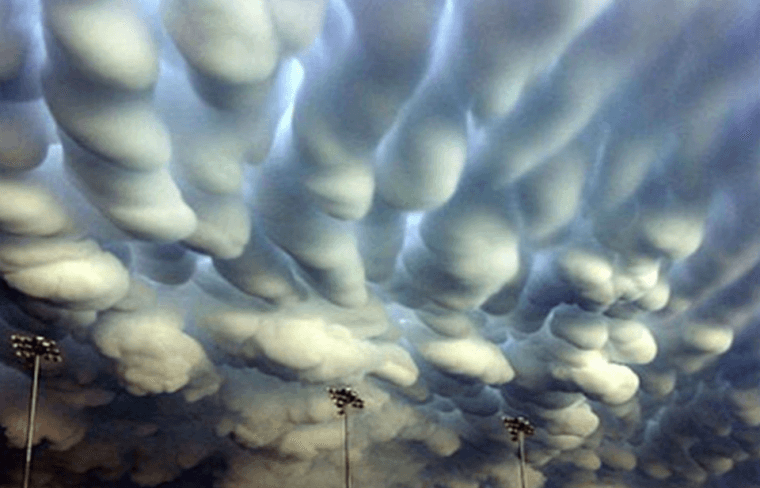
Source: Nasa.gov
Mammatus clouds are made mostly of ice, and, as you can see, they are very large. When they do appear, they can cover hundreds of miles of sky. They typically hang around for ten minutes or a little more. If you see them, get your camera out because it’s a fortunate view. Not everyone has the pleasure of witnessing this fascinating occurrence.
41. Lava Columns
History books show us the beauty of old world ruins – the homes, statues, and buildings created from stone. They are intriguing, to say the least, but it’s hard for any man-made object to beat nature.
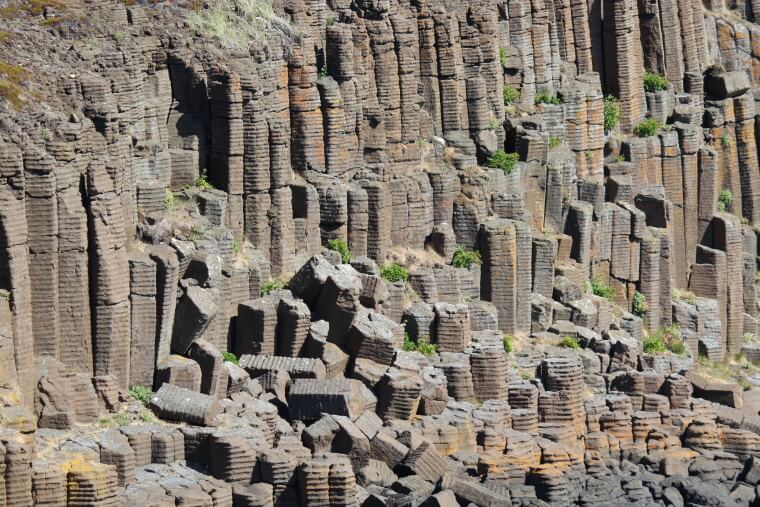
Source: thechive.com
At first glance, these columns appear to be man-made ruins, but they are actually completely natural formations. When a volcano erupts, lava pours out. Over time, it cools, takes shape, and eventually cracks. These columns were formed during such a process.
42. The Blues of Iceland
Ever wonder what it might be like if the movie “Frozen” came to life? You can experience it yourself in Iceland, where white isn’t the only color snow seems to come in.
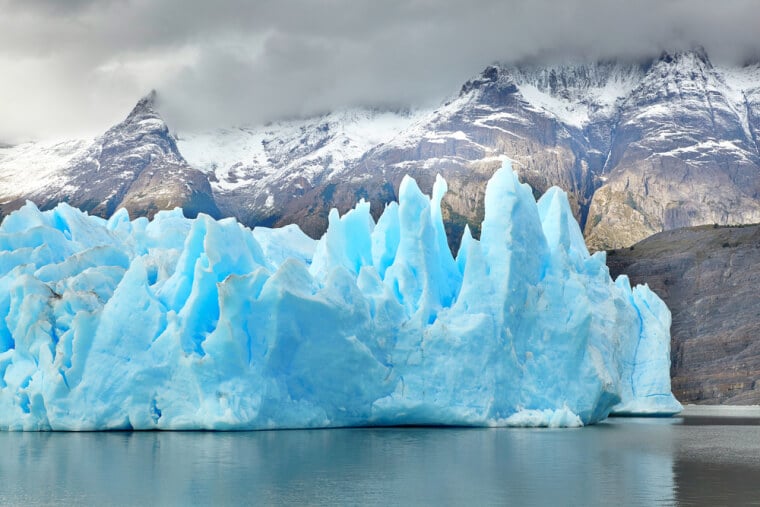
Source: mentalfloss.com
Glaciers are a normal part of the water in cold months, of course, but most glaciers appear to be white. However, as snow falls onto the Icelandic glaciers, it compresses. The mixture of snow and ice makes the glaciers an intense sky blue color. A truly magnificent natural phenomenon to see.
43. Lake Baikal Turquoise Formations
Lake Baikal is a remarkable freshwater lake that is designated a UNESCO World Heritage Site. It has some of the clearest water in the world, giving it a glassy appearance on a regular day.
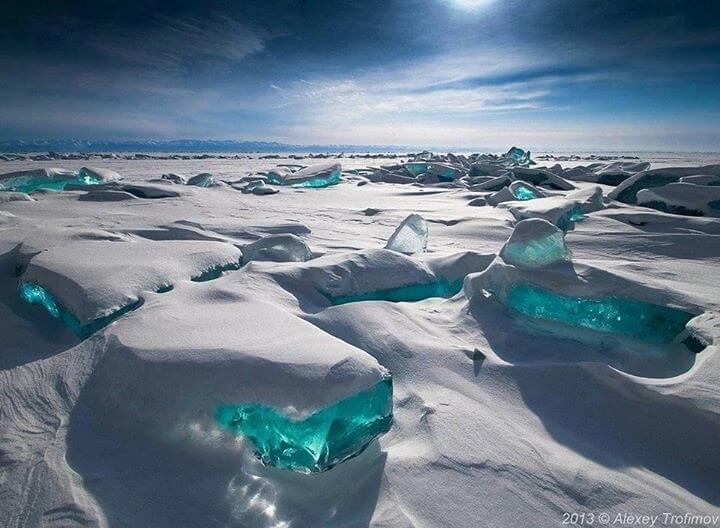
Source: Alexey Trofimov
In the winter, the lake freezes, and that glassy appearance becomes even more visible. Huge chunks of ice can be seen all over the surface, looking oddly similar to rock candy. And thanks to the clear water, that ice shows as a gorgeous hue of turquoise.
44. Pearl Clouds
Clouds can be beautiful on a normal day, but these really take the cake. The mesmerizing array of colors earns these clouds the name “Mother of Pearls.” And though it looks like a manufactured light show in the sky, it’s completely real.
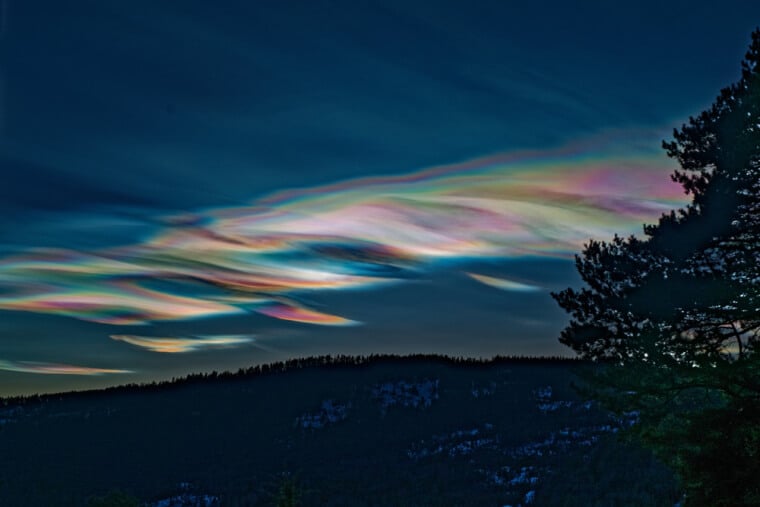
Source: postimees.ee
If you’ve ever played with a prism, you know that when the light hits it in just the right way, you see a rainbow of colors. The same concept happens here, which is why you can only see these clouds well in polar regions as the sun is setting or rising.
45. The Intriguing Appearance of Hair Ice
At first glance the picture below may appear like wool left behind in the woods from a goat shedding its fur. This natural phenomenon is instead known as hair ice or ice wool.
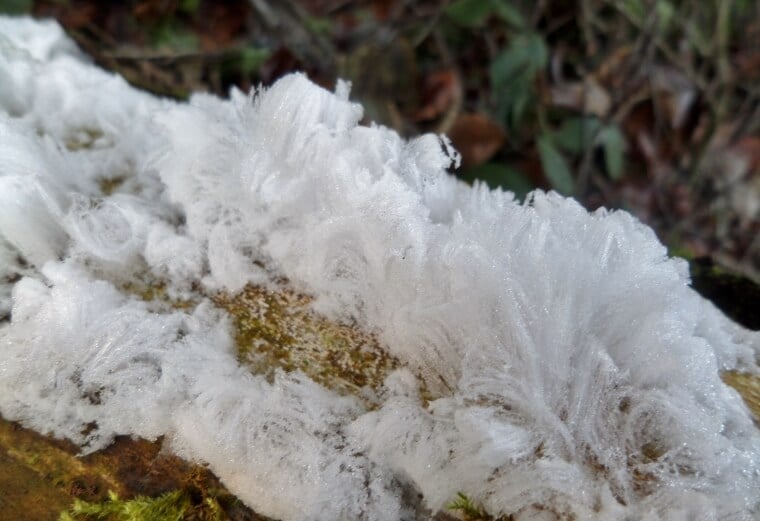
Source: Facebook
This ice formation is rather rare as it requires a very specific climate to produce this silky, wool-like ice. You may be able to find hair ice naturally in leaves and deadwood in broadleaf forests. They are mainly found within locations between latitudes of 45 and 55 °N.
